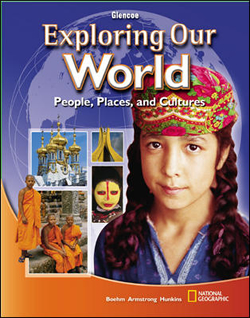Exploring Our World: People, Places, and CulturesChapter 2:
Earth's Physical GeographyWeb Activity Lesson PlansIntroduction
In this chapter, students learned about physical processes that shape the Earth and how these processes influence where people live. The theory of plate tectonics explains how the Earth’s landforms are created and changed. Students will interact with a geological Web site that contains information about the interior forces that shape Earth. An interactive map on the site allows students to insert data so that they can analyze and draw conclusions about it. Lesson Description
Students will visit an interactive geological Web site. On this Web site, they will be able to create maps that illustrate where volcanoes and earthquakes commonly occur in North America. They will then create a map that shows where most seismic activity occurs on the continent. This lesson will help students understand the relationship between the location of seismic activity and plate movement. Instructional Objectives
- The learner will be able to construct maps that include different types of information.
- The learner will be able to compare and contrast information on a map.
- The learner will draw conclusions about the locations of seismic events and the theory of plate tectonics.
Student Web Activity Answers
- along the West coast
- Central America
- the boundaries of tectonic plates
- Pacific Northwest
- There are more volcano eruptions and earthquakes along the borders of tectonic plates.
 | 




